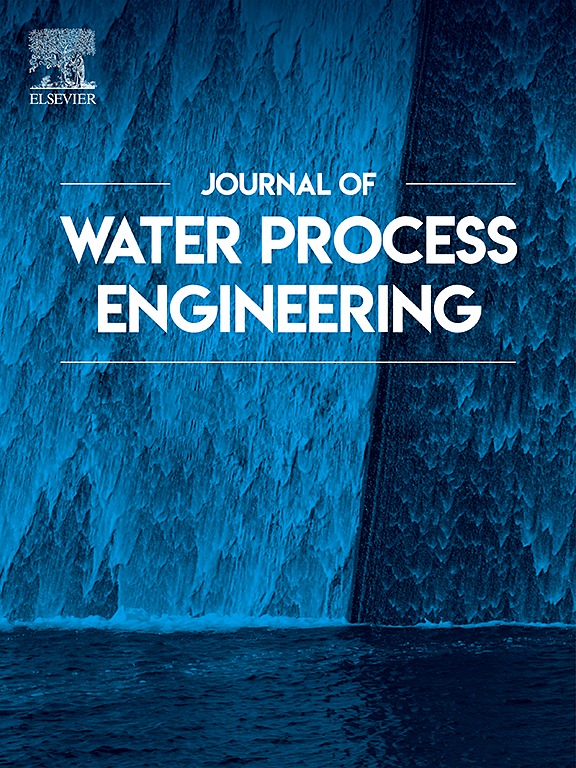Ca/Al复合封盖与水草复合封盖的综合效益:去除沉积物磷,优化沉积物和叶片生物膜的不同微生物功能
IF 6.3
2区 工程技术
Q1 ENGINEERING, CHEMICAL
引用次数: 0
摘要
泥沙改造有利于沉水植物的恢复和稳定,对富营养化浅湖的生态恢复具有重要意义。本研究首次研究了采用简易方法制备的简化钙铝复合材料(SCA)与黑藻(Vallisneria natans)对富营养化沉积物的修复性能及机理。并探讨了水生微生物群落的响应。SCA对磷酸盐的吸附能力为92.26 mg P/g,对磷酸盐具有较高的亲和力。与单一方法相比,SM和SCA联合施用对间质磷和氮的去除效果更好。它们的组合发挥了SCA对沉积物流动磷的转化和紫花草对磷的吸收能力,从而通过总磷去除98.85 mg/kg和流动磷减少8.7%的双重机制减轻了沉积物磷释放的风险。同时,联合修复策略改变了沉积物微生物群落组成,优化了群落结构,增强了沉积物对P、N和碳(C)的保留能力。叶片表面的生物膜在促进P的吸收和C、N的循环和消除中发挥了补充作用,从而最终提高了覆盖水中营养物质的去除率。综上所述,SCA和SM联合使用具有去除沉积物P和优化沉积物和叶片生物膜微生物功能差异的协同效益,在富营养化沉积物修复中具有很大的应用潜力。本文章由计算机程序翻译,如有差异,请以英文原文为准。
Integrated benefits of Ca/Al composites capping coupled with Vallisneria natans: Removal sediment phosphorus and optimization the different microbial functions of sediment and leaf biofilm
Sediment modification would contribute to better restoration and stabilization of submerged macrophytes (SM), which is vital for the ecological recovery of eutrophic shallow lakes. In this study, the remediation performance and mechanisms of simplified calcium‑aluminum composites (SCA), prepared via a simple method, in conjunction with Vallisneria natans on eutrophic sediments were investigated for the first time. And the responses of aquatic microbial communities were also explored. SCA exhibited a strong phosphate adsorption capacity of 92.26 mg P/g and demonstrated high affinity for phosphate. Compared to single approaches, the combined application of SM and SCA was more effective in removing interstitial P and nitrogen (N). Their combination exerted the transformation of sediment mobile P by SCA and the P uptake ability of V. natans, thereby mitigating the risk of sediment P release through the dual mechanisms of total P removal by 98.85 mg/kg and mobile P reduction by 8.7 %. Meanwhile, the joint remediation strategy altered the compositions of sediment microbial communities, optimized community structure, and enhanced the sediment's capacity to retain P, N, and carbon (C). This was complemented by the role of biofilms on leaf surfaces in promoting P uptake and the cycling and elimination of C and N, thus ultimately improving the removal rates of nutrients from the overlaying water. These results suggested that the combination of SCA and SM has the synergistic benefits of removing sediment P and optimizing the microbial functions differed between sediment and leaf biofilms, and has great potential for application in eutrophic sediment remediation.
求助全文
通过发布文献求助,成功后即可免费获取论文全文。
去求助
来源期刊

Journal of water process engineering
Biochemistry, Genetics and Molecular Biology-Biotechnology
CiteScore
10.70
自引率
8.60%
发文量
846
审稿时长
24 days
期刊介绍:
The Journal of Water Process Engineering aims to publish refereed, high-quality research papers with significant novelty and impact in all areas of the engineering of water and wastewater processing . Papers on advanced and novel treatment processes and technologies are particularly welcome. The Journal considers papers in areas such as nanotechnology and biotechnology applications in water, novel oxidation and separation processes, membrane processes (except those for desalination) , catalytic processes for the removal of water contaminants, sustainable processes, water reuse and recycling, water use and wastewater minimization, integrated/hybrid technology, process modeling of water treatment and novel treatment processes. Submissions on the subject of adsorbents, including standard measurements of adsorption kinetics and equilibrium will only be considered if there is a genuine case for novelty and contribution, for example highly novel, sustainable adsorbents and their use: papers on activated carbon-type materials derived from natural matter, or surfactant-modified clays and related minerals, would not fulfil this criterion. The Journal particularly welcomes contributions involving environmentally, economically and socially sustainable technology for water treatment, including those which are energy-efficient, with minimal or no chemical consumption, and capable of water recycling and reuse that minimizes the direct disposal of wastewater to the aquatic environment. Papers that describe novel ideas for solving issues related to water quality and availability are also welcome, as are those that show the transfer of techniques from other disciplines. The Journal will consider papers dealing with processes for various water matrices including drinking water (except desalination), domestic, urban and industrial wastewaters, in addition to their residues. It is expected that the journal will be of particular relevance to chemical and process engineers working in the field. The Journal welcomes Full Text papers, Short Communications, State-of-the-Art Reviews and Letters to Editors and Case Studies
 求助内容:
求助内容: 应助结果提醒方式:
应助结果提醒方式:


